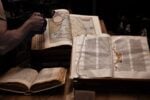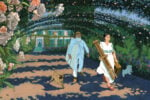Hedda Sterne – Metamorphoses
 (1200x1199).jpg)
Mostra personale.
Comunicato stampa
Victoria Miro is delighted to present Metamorphoses, the gallery’s first exhibition of works by Hedda Sterne (1910–2011) since announcing representation of the artist.
An active member of the New York School, Hedda Sterne, who was born in Bucharest, Romania in 1910 and fled to the US in 1941, created an extensive body of work that intersected with some of the most important movements and figures of the twentieth century. A bridge between European Modernism, in particular Surrealism, and American Abstract Expressionism, Sterne’s work stands as a testament to her independence of thought, moving freely between figuration and abstraction throughout her long career. Sterne stated, ‘I believe… that isms and other classifications are misleading and diminishing. What entrances me in art is what cannot be entrapped in words.’
The works in this exhibition are drawn from the late 1960s and early 1970s. The 1960s were an especially productive decade for Sterne, her work becoming increasingly abstract, minimal and experimental as the decade progressed, while also drawing clear inspiration from natural phenomena and elements of landscape. During this period Sterne began meditating daily, a practice that would have a profound effect on her life and work. In 1961, she spent time at Yaddo as an artist in residence, and in 1963, she travelled to Venice, where she would live and work as a Fulbright fellow until the summer of 1964. Shortly after her return to the US, she purchased a property in the East Hampton Springs community, which became her summer home and studio for several decades, and where she was able to work on ever larger canvases, and experiment in profoundly new ways.
Works on view include important paintings from 1967 created by pouring thinned acrylic paint on to raw canvas, Sterne accepting the element of chance and then returning to the canvases to reinterpret and draw out the forms through the addition of lines or swathes of overpainting. She likened the forms that emerged to the dense folds of lettuce leaves, which for Sterne became metaphors for growth and metamorphosis.
Contemporary with the Lettuce works, and a corollary to them, are drawings from a series Sterne would title Baldanders, an invented compound term of the German words for ‘soon’ and ‘change’. In these, tightly formed objects are centred and contained in large, blank white spaces. Sterne began the drawings with loose movements, allowing lines to flow automatically from her hand to page. At certain moments, as the work grew and changed, she would take back control, directing focus to one space or another to push forward emerging forms, figures and expressions. Ultimately, Sterne wasn’t seeking to relay one vision, she was embracing and moving with rapid change as the work developed.
By the early 1970s, Sterne’s preoccupation with change and movement brought her back to the form of the tondo, which she had previously explored at the beginning of the 1950s, and through which she emphasised the way a work can change its effect by a simple rotation. The tondo paintings, two of which are on view, were made with thinned acrylic on raw canvas, some entirely absent of further artistic intervention, others with barely present curves of brushed-on paint. With the circular form, she further did away with control – in her process of making and our viewing of the work, the shape does not impose orientation. Ideally, she suggested, the tondos would be seen turning slowly. Sterne’s desire to capture the essence of change and flux, present in these works in various ways, reflects the roots of her practice in the European avant-garde, and presages much of what lay ahead in her life and art practice. Sterne’s final artist’s statement, composed in 2004, articulates what she felt to be a primary achievement of her life in art: ‘With time, I have learned to lose my identity while drawing and to act simply like a conduit, permitting visions that want to take shape to do so.’
About the artist
Hedda Sterne was born in Bucharest, Romania in 1910. She was a part of the city’s thriving avant-garde community during the interwar period and was mentored by Dada co-founder Marcel Janco and Surrealist Victor Brauner. Between 1927 and 1932 she travelled frequently to Vienna and Paris, where she attended classes in the ateliers of André Lhote and Fernand Léger, and at the Académie de la Grande Chaumière. She studied art history and philosophy at the University of Bucharest from 1929 to 1932. That year, she married Friederich (Fritz) Stern, and during the following decade continued her artist practice while travelling between Bucharest and Paris. In 1938 she was included in the 11th annual Salon des Surindépendants, where her collages draw the attention of Jean Arp and Peggy Guggenheim.
Returning to her family in Bucharest in the lead up to World War II in 1939, Sterne witnessed the Romanian Iron Guard Revolt and Bucharest Pogrom in 1941. Later that year, she was able to travel to Lisbon and from there to New York, where she joined her husband who had left Romania on a business visa in 1940. Sterne established a studio on East 50th Street in 1942, becoming close friends with her neighbours Peggy Guggenheim and Max Ernst. Through Guggenheim she was introduced to artists including Piet Mondrian, André Breton and Marcel Duchamp. Breton and Duchamp included Sterne in the 1942 exhibition First Papers of Surrealism, Sterne’s first group exhibition in the United States.
In 1943, Peggy Guggenheim began to exhibit Sterne’s work at the Art of This Century gallery. That year, she also met Betty Parsons, who would become her long-time gallerist and close friend, and the artist and fellow Romanian émigré Saul Steinberg, who was commissioned as an ensign in the US Naval Reserve and soon departed on active duty. They corresponded regularly over the following year. In the summer of 1944, Sterne’s divorce from Fritz Stafford was finalised. (Fritz and Hedda had changed their German-sounding surname from Stern to Stafford in 1941, though since she had been building her career with her original married name, she soon began to exhibit her work as Hedda Sterne, a nom de plume through the addition of an ‘e’). She married Steinberg in October 1944. While the pair separated in 1960, they were never divorced.
Sterne’s first solo exhibition in the US took place in 1943, organised by Betty Parsons at the Wakefield Gallery. When Parsons opened her own gallery in 1946, Sterne was one of 16 artists represented by the pioneering gallery at its founding, along with Mark Rothko, Barnett Newman and Ad Reinhardt. In 1950, Sterne was named one of the country’s best artists under the age of 36 by Life magazine and that year was one of 28 artists to sign an open letter to the president of the Metropolitan Museum of Art, protesting the museum’s aesthetically conservative group exhibition juries. Life magazine published an article about the letter in a January 1951 issue. Sterne was among 15 of the signatories photographed by Nina Leen for the article. The image, subtitled ‘Irascible Group of Advanced Artists’, includes, among others, Barnett Newman, Mark Rothko, Jackson Pollock, Clyfford Still, Robert Motherwell, Willem De Kooning, Adolph Gottlieb, Ad Reinhardt. Sterne, the only woman, can be seen standing on a table at the very top. The photograph is one of the defining images of the New York School.
In 1963, awarded a Fulbright fellowship in painting, Sterne lived and worked for over a year in Venice, where she developed her Vertical-Horizontals. She began a daily practice of meditation in 1966, which became important for the rest of her life. Sterne continued to make paintings, drawings and prints, exhibiting widely through to the 2000s. She died in New York in 2011 at the age of 100.
Retrospective exhibitions have been mounted at the Montclair Art Museum, New Jersey in 1977 and at the Queens Museum in Flushing Meadow, New York in 1985. Hedda Sterne: Dessins (1939–1998), a retrospective of drawings, was held at Bibliothèque Municipale, Ville de Caen, in 1998. Uninterrupted Flux: Hedda Sterne, A Retrospective was held at the Krannert Art Museum, University of Illinois at Urbana-Champaign in 2006, touring in 2007 to the University of Virginia Art Museum, Charlottesville, Virginia. Sterne’s work has enjoyed increased critical visibility in recent years, featuring in major group exhibitions and museum displays, such as The Form of Freedom: International Abstraction after 1945 at Museum Barberini, Potsdam (4 June–25 September 2022); Midcentury Abstraction: A Closer Look at the Yale University Art Gallery (2022); Elles font l’abstraction at Centre Pompidou, Paris (2021); Labyrinth of Forms: Women and Abstraction, 1930-1950 at the Whitney Museum of American Art, NY (2021-22); Affinities for Abstraction: Women Artists on Eastern Long Island, 1950–2020, at Parrish Art Museum, NY (2021); Epic Abstraction: Pollock to Herrera at The Met Fifth Avenue, NY (2018–20); Hedda Sterne: Printed Variations at Amon Carter Museum of American Art, TX (2018-19); Making Space: Women Artists and Postwar Abstraction at MoMA, NY (2017). A solo exhibition was held at Victoria Miro in London in 2020.
Her works are represented in major international collections including The Art Institute of Chicago, Carnegie Museum of Art, Pittsburgh, the National Gallery of Art, and the Smithsonian American Art Museum, Washington, D.C., The Metropolitan Museum of Art, Whitney Museum of American Art and the Museum of Modern Art, New York, Musée National d’Art Moderne, Centre Pompidou, Paris, France, and Tate, UK.



